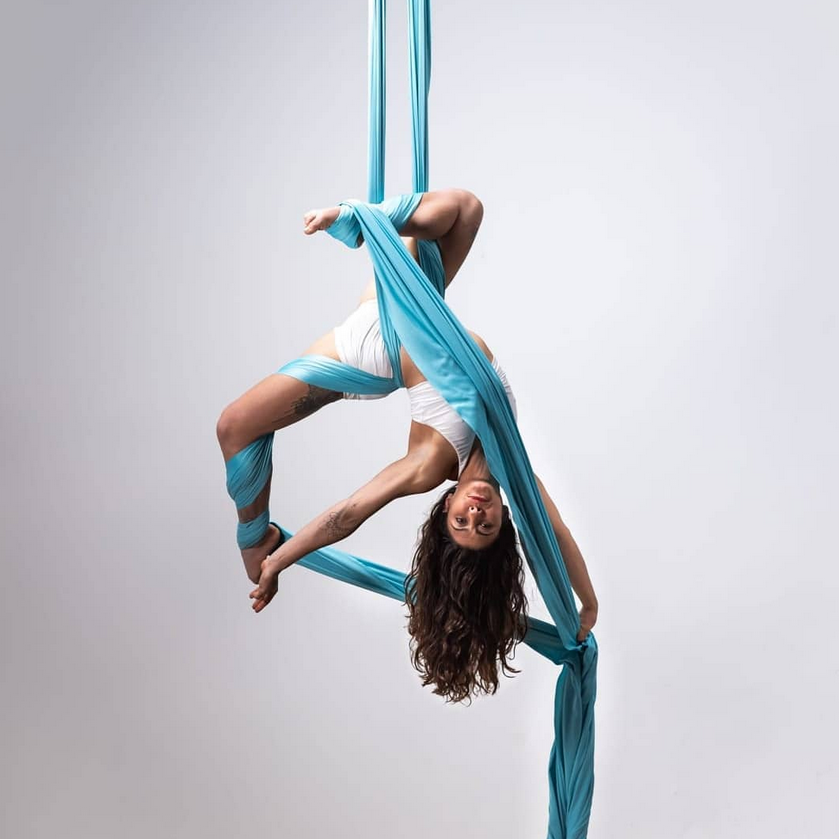LEARN FLOW ARTS
The Disciplines Which We Offer Are:
Poi spinning is an engaging and visually captivating performance art form that originated in the Maori culture of New Zealand. It involves manipulating tethered weights, known as poi, in various rhythmic and flowing patterns. Poi can be made of different materials such as fabric, chains, or even fire-resistant materials for fire poi.
For beginners, understanding a few key concepts is essential to start their poi spinning journey:
Grip and Plane Control: Establishing a comfortable grip on the poi handles is crucial. Beginners often start with a double finger loop grip, which provides a balance between control and flexibility. Other options are “single finger loop” and “poi knob grip” (knobs are useful for advanced poi spinning, for doing tosses and two poi in one hand, but they are becoming increasingly popular with beginners as well. Plane control refers to the path through which the poi move. Beginners should focus on keeping their poi in the same plane, which could be front-back (wall plane), side-to-side (wheel plane), or the horizontal plane (above the head and in front of you), before making a combination out of them.
Timing and Direction: Poi spinning involves coordinating the movement of both poi in harmony. The timing refers to the rhythm and synchronization between the two poi. Beginners should practice maintaining a consistent timing to create visually appealing patterns. Direction refers to the orientation of the poi in relation to the spinner’s body. Understanding and controlling the direction of the poi helps in creating diverse patterns.
Basic Moves: Beginners should start with fundamental moves that form the building blocks of poi spinning. Some common moves include weaves, butterfly, reels, and fountain. These moves provide a foundation for more complex patterns and can be combined to create visually striking performances.
Flow and Transitions: Flow is an essential aspect of poi spinning, involving smooth and continuous movement between different moves and patterns. Beginners should focus on maintaining a steady rhythm and seamlessly transitioning between various techniques. Developing flow enhances the aesthetics of the performance.
Safety: Safety is paramount, especially when working with fire poi. Beginners should prioritize safety by wearing appropriate clothing, maintaining a safe distance from flammable objects, and practicing in a well-ventilated area. It’s crucial to learn and follow safety guidelines to ensure a secure and enjoyable experience.
Practice and Persistence: Like any skill, poi spinning requires practice and persistence to improve. Regular practice sessions, starting with short durations and gradually increasing, can help beginners develop muscle memory, coordination, and control over their poi.
Remember, poi spinning is not just about mastering specific moves; it’s an art form that allows for creativity and self-expression. As beginners progress, they can explore different styles, incorporate dance-like movements, and experiment with different types of poi to create their unique spinning style.
Welcome to the captivating world of staff spinning! Staff spinning is an exhilarating flow art that combines movement, rhythm, and visual spectacle. It involves manipulating a long staff, typically made of wood or metal, in a variety of dynamic and graceful patterns.
Originating from ancient cultures across the globe, staff spinning has evolved into a contemporary performance art form. It blends elements of martial arts, dance, and object manipulation to create mesmerizing displays of skill and creativity.
As a beginner in staff spinning, you’ll embark on a journey that will challenge and inspire you. Here are some important aspects to understand:
Grip and Control: Establishing a comfortable and secure grip on the staff is crucial. Beginners often start with a single-handed grip, gradually progressing to two-handed techniques. Developing control over the staff allows for fluid movements and precision in executing tricks and transitions.
Plane Control and Spacing: Understanding and maintaining proper plane control is essential. The staff moves through different planes – vertical, horizontal, and diagonal – creating geometric patterns. Beginners should focus on keeping the staff in the same plane and explore spacing to create dynamic visual effects.
Basic Moves and Techniques: Starting with fundamental moves forms the foundation of staff spinning. Some common techniques include spins, passes, throws, and rolls. Learning these moves helps develop coordination, timing, and muscle memory, which are vital for more advanced tricks and combinations.
Flow and Musicality: Flow refers to the seamless and continuous movement between different tricks and patterns. It emphasizes the rhythmic connection between the spinner, the staff, and the accompanying music. Developing flow enhances the visual aesthetics and brings a sense of grace and harmony to your performances.
Performance and Expression: Staff spinning offers a platform for self-expression and creativity. As you progress, you’ll have the opportunity to explore your unique style, incorporating dance-like movements, body rolls, and even contact staff techniques. Experimenting with different styles and exploring choreography allows you to create captivating and personal performances.
Safety: Safety should always be a priority when practicing staff spinning. Choosing an appropriate practice space, using a staff of suitable weight and length, and wearing protective gear, such as wrist guards, are essential precautions. Always be mindful of your surroundings and practice in a safe and controlled environment.
Remember, staff spinning is not just about mastering technical moves; it’s about cultivating a connection between mind, body, and the staff itself. Embrace the joy of exploration, dedication to practice, and the artistry that flows through each movement.
Join the vibrant community of staff spinners, where you can share your journey, exchange knowledge, and inspire others with your unique flow. Embark on this enchanting path, and let your staff become an extension of your creative expression.
Welcome to the enchanting realm of dragon staff spinning! Dragon staff spinning is an awe-inspiring and visually captivating flow art that combines elements of staff manipulation and contact staff techniques. It involves manipulating a specialized staff with additional spokes or “wings” that resemble the mythical creature, the dragon.
Originating from the fire spinning community, dragon staff spinning has evolved into a distinct and mesmerizing performance art. It offers a unique and dynamic way to express creativity, combining intricate patterns, body rolls, and contact moves.
As a beginner in dragon staff spinning, you’ll embark on an exciting journey that combines fluidity, technicality, and artistry. Here are some important aspects to understand:
Grip and Control: Establishing a solid grip on the dragon staff is crucial. Beginners often start with a single-handed grip, gradually progressing to two-handed techniques. Developing control over the staff and the wings allows for precise movement and manipulation.
Plane Control and Spacing: Understanding and maintaining proper plane control is essential for dragon staff spinning. The staff and wings move through various planes, creating captivating geometric patterns. Beginners should focus on keeping the dragon staff in the same plane and explore spacing to create dynamic visual effects.
Basic Moves and Techniques: Starting with fundamental moves forms the foundation of dragon staff spinning. Some common techniques include spins, isolations, body rolls, and contact moves. Learning these moves helps develop coordination, timing, and body awareness, which are vital for more advanced tricks and combinations.
Flow and Transitions: Flow is an integral aspect of dragon staff spinning, emphasizing the seamless and continuous movement between different tricks and patterns. Developing flow enhances the visual aesthetics and brings a sense of grace and harmony to your performances. Smooth transitions and rhythmically connecting moves create captivating displays.
Performance and Creativity: Dragon staff spinning offers a platform for personal expression and creativity. As you progress, you’ll have the opportunity to explore your unique style, incorporating dance-like movements, acrobatics, and contact staff techniques. Experimenting with choreography and storytelling allows you to create mesmerizing and immersive performances.
Safety: Safety should always be a priority when practicing dragon staff spinning. Choosing an appropriate practice space, using a well-balanced and properly weighted dragon staff, and wearing protective gear are essential precautions. Always be mindful of your surroundings and practice in a safe and controlled environment.
Join the vibrant community of dragon staff spinners, where you can share your journey, exchange knowledge, and inspire others with your unique flow. Embrace the magic of dragon staff spinning, let your creativity soar, and unleash the captivating power of the dragon in your performances.
Welcome to the mesmerizing and daring world of fire eating! Fire eating is an ancient performance art that has fascinated audiences for centuries. It involves the skilled manipulation of fire using the mouth, creating a captivating spectacle that combines danger, skill, and artistry.
Originating from various cultures around the world, fire eating has evolved into a captivating form of entertainment. It requires a high level of control, precision, and safety precautions to perform safely. Here are some important aspects to understand:
Safety First: Fire eating is an art form that carries inherent risks. Safety should always be the top priority. It is essential to undergo proper training, learn from experienced fire eaters, and follow safety protocols. Fire eaters should use specially designed tools, practice in controlled environments, and wear appropriate safety gear, such as fire-resistant clothing and gloves.
Fuel and Flames: Fire eaters typically use paraffin-based fuels, such as lamp oil or white gas, to create flames. Understanding the properties of different fuels and how they interact with fire is crucial. Fire eaters must learn the proper technique for soaking the tools, managing flame size, and extinguishing the flames safely.
Technique and Skill: Fire eating requires mastery of various techniques. Beginners should start with foundational moves, such as transferring the flame from a torch to the mouth and extinguishing the fire safely. As skills progress, fire eaters can explore more advanced techniques, including vapor transfers, fireballs, and even fire breathing.
Breath Control and Protection: Fire eaters must develop excellent breath control to minimize the risk of inhaling flames or hot gases. They learn to manipulate their breath to extinguish the flames smoothly and safely. Additionally, using protective coatings, such as non-toxic substances like cornstarch or specialized fire-eating powders, can provide an extra layer of protection for the mouth and throat.
Performance and Artistry: Fire eating is not just about the technical skills; it’s also about creating a captivating performance. Fire eaters can incorporate choreography, dance, and storytelling into their acts, allowing for a rich and immersive experience for the audience. Combining fire eating with other flow arts or performance elements can further enhance the visual impact.
Continuous Learning and Safety Awareness: Fire eating is a discipline that requires ongoing learning and practice. Fire eaters should stay updated on safety guidelines, attend workshops, and continually refine their skills. It’s essential to remain aware of the risks involved and take all necessary precautions to ensure a safe and captivating performance.
Join the vibrant community of fire eaters, where you can connect with fellow performers, learn from experienced artists, and share your passion for this thrilling art form. Embrace the daring and mystical nature of fire eating, and ignite the stage with your mesmerizing performances.
Welcome to the exhilarating world of fire breathing! Fire breathing, also known as fire spitting or fire blowing, is a captivating and daring performance art that combines skill, precision, and a touch of danger. It involves exhaling a fine mist of fuel through a flame, creating mesmerizing fireballs and impressive displays of controlled pyrotechnics.
Fire breathing has a rich history, originating from ancient cultures where it was used in rituals and performances. Today, it has evolved into a popular form of entertainment, captivating audiences with its visual spectacle. Here are some important aspects to understand:
Safety First: Fire breathing is an art form that carries inherent risks. Safety should always be the top priority. It is absolutely crucial to undergo extensive training from experienced fire breathers and to strictly adhere to safety guidelines. Fire breathers must use specially formulated fuels, practice in controlled environments, and wear appropriate safety gear, including fire-resistant clothing, goggles, and protective barriers.
Fuel Selection: Fire breathers are known for using kerosene based fuels such as lamp oil because they are the safest option fire breathing. These fuels have a high flash point and low toxicity, making them far superior to napthalene based fuels which can be explosive! It is very important to understand the properties and safety considerations of different fuels and use them responsibly.
Technique and Skill: Fire breathing requires a high level of technique and skill. It involves controlling the amount of fuel in the mouth, regulating the airflow, and creating a fine mist for ignition. Fire breathers must practice proper breath control and learn to create controlled fireballs while maintaining safety and minimizing the risk of inhaling flames and hot gases or swallowing fuel.
Safety Distance and Wind Conditions: Fire breathers must be mindful of safety distances and perform in appropriate wind conditions. They should ensure a safe distance between themselves, the audience, and any flammable objects. Wind direction and speed can affect the behavior of the flames and the safety of the performance, so fire breathers should carefully assess and adapt to the surrounding environment.
Continuous Learning and Safety Awareness: Fire breathing is a discipline that requires ongoing learning, practice, and safety awareness. Fire breathers should continually update their knowledge, attend workshops, and stay updated on safety guidelines. It is essential to remain aware of the risks involved and take all necessary precautions to ensure a safe and awe-inspiring performance.
Join the vibrant community of fire breathers, where you can connect with fellow performers, learn from experienced artists, and share your passion for this thrilling art form. Embrace the exhilaration and mystique of fire breathing, and ignite the stage with your breathtaking displays of controlled fire manipulation.
Many Disciplines
Wide selection of skills offered and props available.
Individual Attention
One on one focused coaching and insights.
Affordable
Charged hourly, with discounts for more hours.
1 - on - 1 Flow Arts Coaching
Here we have some images of Halen teaching a 1-on-1 dragon staff class with his student Sophie.
He understands that we all learn differently and thus, likes to combine demonstration and explanation, with hands on assistance. By breaking each movement down into easily repeatable steps, we slow down the overall motion helping students to learn as efficiently as possible.




"Practice Slowly, Learn Fast"
Aerial Arts
Experience the Benefits of Learning Aerial Silks
Aerial silks offer a unique and exhilarating way to stay fit, build strength, and express creativity. Whether you’re looking for a new fitness challenge or a way to enhance your performance skills, learning aerial silks comes with a multitude of benefits:
1. Full-Body Workout
Aerial silks engage your entire body, helping to build muscle strength and improve flexibility. As you lift, twist, and maneuver your body through the silks, you target core muscles, arms, legs, and back, providing a comprehensive workout.
2. Improved Coordination and Balance
Performing aerial routines requires precise movements and body awareness, enhancing your coordination and balance. Over time, you’ll develop better control and fluidity in your movements, both on and off the silks.
3. Enhanced Flexibility
Regular practice of aerial silks helps to lengthen and stretch your muscles, increasing your overall flexibility. Improved flexibility not only enhances your performance but also reduces the risk of injuries in other physical activities.
4. Mental Focus and Confidence
Aerial silks demand concentration and mental focus, promoting mindfulness and reducing stress. As you master new moves and routines, you’ll experience a boost in confidence and a sense of accomplishment.
5. Creative Expression
Aerial silks provide a unique platform for artistic expression. You can choreograph your own routines, combining strength, grace, and creativity to tell a story or convey emotions through movement.
6. Community and Support
Joining an aerial silks class introduces you to a supportive and inspiring community of like-minded individuals. You’ll share your progress, celebrate achievements, and encourage each other, fostering strong social connections.
Embark on your aerial silks journey today and experience the transformative benefits that go beyond the physical. Elevate your fitness, express your creativity, and soar to new heights with aerial silks.
Find our class schedule here – https://flyingfitness.co.za/
Discover the Benefits of Learning Lyra (Aerial Hoop)
Lyra, also known as the aerial hoop, is a captivating and challenging aerial art form that offers numerous physical and mental benefits. Whether you’re seeking a new fitness routine or an outlet for creative expression, learning Lyra can transform your body and mind in exciting ways:
1. Full-Body Conditioning
Training on the Lyra engages all major muscle groups, providing an effective full-body workout. As you perform lifts, spins, and holds, you’ll develop strength in your core, arms, shoulders, and legs, enhancing overall muscle tone and endurance.
2. Improved Flexibility and Mobility
Lyra routines require a range of motion and fluid movements that help increase your flexibility and joint mobility. Regular practice can lead to greater flexibility, reducing the risk of injuries and improving performance in other physical activities.
3. Enhanced Balance and Coordination
Executing moves on the aerial hoop demands precise balance and coordination. As you learn to stabilize and control your body in various positions, you’ll improve your overall balance and coordination, benefiting other aspects of your physical life.
4. Mental Focus and Stress Relief
Lyra practice requires concentration and mindfulness, providing a meditative experience that can reduce stress and improve mental clarity. The focus needed to execute routines can help quiet the mind and enhance mental well-being.
5. Boosted Confidence and Self-Esteem
Mastering the challenges of Lyra builds confidence and a sense of accomplishment. Each new move or routine you conquer boosts your self-esteem, empowering you to tackle other challenges with greater assurance.
6. Artistic Expression
Lyra offers a unique platform for creative expression. You can choreograph routines that combine strength, grace, and emotion, allowing you to tell a story or convey feelings through your movements on the hoop.
7. Community and Support
Joining a Lyra class connects you with a community of supportive and like-minded individuals. Sharing progress, celebrating achievements, and offering encouragement fosters strong social bonds and a sense of belonging.
Dive into the world of Lyra and experience the incredible benefits it offers. Strengthen your body, sharpen your mind, and express your creativity as you soar through the air on the aerial hoop.
Experience the Benefits of Learning Trapeze
Learning trapeze is an exhilarating and rewarding journey that combines physical fitness, artistic expression, and mental discipline. Whether you’re looking to enhance your workout routine or explore new creative avenues, trapeze offers a multitude of benefits:
1. Comprehensive Physical Fitness Trapeze training provides a full-body workout, strengthening your core, arms, legs, and back. The dynamic movements and holds required in trapeze routines build muscle endurance, increase cardiovascular health, and improve overall physical fitness.
2. Enhanced Flexibility and Agility The aerial movements and poses in trapeze require and develop flexibility and agility. Regular practice helps lengthen muscles and improve joint mobility, leading to greater flexibility and reduced risk of injury.
3. Improved Balance and Coordination Performing on the trapeze enhances your balance and coordination. As you learn to maintain stability and execute precise movements in the air, you’ll develop better control over your body, which can benefit other physical activities.
4. Mental Focus and Stress Relief Trapeze demands concentration and mental discipline, promoting mindfulness and reducing stress. The focus required to perform complex routines can help clear your mind, providing a mental escape and improving overall well-being.
5. Increased Confidence and Self-Esteem Overcoming the challenges of trapeze training builds confidence and self-esteem. Each new skill or routine you master brings a sense of accomplishment, empowering you to face other challenges with greater confidence.
6. Creative Expression Trapeze offers a unique platform for artistic expression. You can create and perform routines that blend strength, grace, and storytelling, allowing you to convey emotions and narratives through your aerial performance.
7. Community and Camaraderie Joining a trapeze class connects you with a community of supportive and passionate individuals. Sharing progress, celebrating milestones, and encouraging each other fosters strong social connections and a sense of belonging.
Embark on your trapeze journey today and unlock the incredible benefits it offers. Strengthen your body, elevate your mind, and express your creativity as you soar through the air on the trapeze.
Group Aerial Classes
Jesyka Sham, of Flying Fitness, started offering aerial silks classes in 2015 and has since taught 100’s of aerial enthusiasts. Incorporating all that she has learnt on the ground in her many years performing, dancing, training martial arts and coaching gymnastics, she has and is able to produce high level aerial artists.

Performances
Exotic multi-prop solo and duo choreographed and freestyle fire acts, performed by seasoned professionals.
Gear
Premium quality performance gear, custom made for the most discerning of pyromaniacs.
Training
Well rounded, structured and intuitive one-on-one and group flow coaching sessions, designed to take your skills to the next level.
